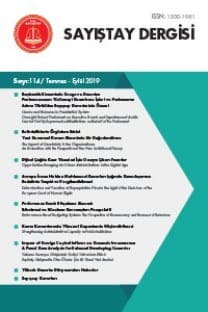Cari Açık Ekonomi Üzerindeki Finansal Baskıyı Artırıyor mu?
Cari açık, Finansal baskı, Nedensellik
IS CURRENT ACCOUNT DEFICIT INCREASING THE FINANCIAL PRESSURE ON THE ECONOMY?
Current account deficit, Financial pressure, Causality,
___
- Ashcroft, Vincent ve Cavanough, David (2008), “Survey of Recent Developments”, Bulletin of Indonesian Economic Studies, 44(3): 335-363.
- Avcı, Muhammet Ali ve Altay, Nasuh Oğuzhan (2013), “Finansal Krizlerin Sinyal Yaklaşımı ile Öngörülmesi: Türkiye, Arjantin, Tayland ve İngiltere İçin Bir Analiz”, Pamukkale Üniversitesi Sosyal Bilimler Enstitüsü Dergisi, 14, 47-58.
- Bhattacharya, Basabi ve Mukharjee, Jaydeep (2002), “Causal Relationship between Stock Market and Exchange Rate, Foreign Exchange Reserves and Value of Trade Balance: A Case Study for India”, http://www.igidr.ac.in/money/mfc_5/ basabi.pdf, [14.07.2013].
- Borio, Claudio ve Disyatat, Piti (2010), “Global Imbalances and the Financial Crisis: Reassessing the Role of International Finance”, Asian Economic Policy Review, 5, 198–216.
- Bunda, Irina ve Ca’ Zorzi, Michele (2010), “Signals from Housing and Lending Booms”, Emerging Markets Review 11, 1–20.
- Carrion-i-Silvestre, Josep LLuis, Kim, Dukpa ve Perron, Pierre (2009), “GLS-Based Unit Root Tests with Multiple Structural Breaks Under Both the Null and the Alternative Hypotheses”, Econometric Theory, 25, 1754-1792.
- Çelik, Arzum Erken ve Karatepe, Yalçın (2007), “Evaluating and Forecasting Banking Crises Through Neural Network Models: An Application for Turkish Banking Sector”, Expert Systems with Applications, 33, 809-815.
- Çil Yavuz, Nilgün (2006), “Türkiye’de Turizm Gelirlerinin Ekonomik Büyümeye Etkisinin Testi: Yapısal Kırılma ve Nedensellik Analizi”, Doğuş Üniversitesi Dergisi, 7 (2), 162-171.
- Dornbusch, Rudiger ve Fischer, Stanley (1990), Macroeconomics, McGraw-Hill, International Editions.
- Edison, Hali J. (2000), “Do Indicators of Financial Crises Work? An Evaluation of an Early Warning System”, International Journal of Finance & Economics, 8 (1), 11-53.
- Eichengreen, Barry J. (1994), International Monetary Arrangements for the 21st Century, Washington: Brooking Institution.
- Fioramanti, Marco (2008), “Predicting Sovereign Debt Crises Using Artificial Neural Networks: A Comparative Approach”, Journal of Financial Stability, 4, 149-164.
- Frankel, Jeffrey A. ve Rose, Andrev K. (1996), “Currency Crashes in Emerging Markets: An Emprical Treatment”, Journal of International Economics, 41, 351-366.
- Freund, Caroline (2000), “Current Account Adjustment in Industrialized Countries”, Board of Governers of the FED International Finance, Discussion Papers, No. 692.
- Glick, Reuven ve Moreno, Ramon (1999), “Money and Credit, Competitiveness and Currency Crises in Asia and Latin America”, Pacific Basin Working Paper Series No. 99-01, Federal Reserve Bank of San Francisco.
- Kaminsky, Graciela ve Reinhard, Carmen M. (1999), “The Twin Crises: The Causes of Banking and Balance of Payments Problems”, American Economic Review, 3(49), 473-500.
- Karakayalı, Hüseyin ve Sayın, Ferhan (2010), “Öncü Göstergeler Yaklaşımıyla Türkiye’de 2008 Krizinin Değerlendirilmesi”, Finans Politik & Ekonomik Yorumlar, 47(546), 33-55.
- Kibritçioğlu, Aykut (2004), “An Analysis of Early Warning Signals of Currency Crises in Turkey, 1986-2004”, http://kibritcioglu.socionet.ru/files/OENB- Kibritcioglu-20041108.pdf, [29.07.2013].
- Lee, Junsoo ve Strazicich, Mark C. (2003), “Minimum Lagrange Multiplier Unit Root Test with Two Structural Breaks”, The Review of Economics and Statistics, 85(4), 1082-1089.
- Licchetta, Mirko (2011), “Common Determinants of Currency Crises: The Role of External Balance Sheet Variables”, International Journal of Finance and Economics, 16: 237–255.
- Lumsdaine, Robin L. ve Papell, David H. (1997), “Multiple Trend Breaks and The Unit Root Hypothesis”, The Review of Economics and Statistics, 79, 212-218.
- Mankiw, N. Gregory (1989), “Real Business Cycles: A New Keynesian Perspective”, The Journal of Economic Perspectives, 3(3), 79-80.
- Milesi-Ferrett, Gian Maria ve Razin, Assaf (1998), “Current Account Reversals and Currency Crises: Empirical Regularities”, NBER Working Paper, No. 6620.
- Montoro, Carlos ve Rojas-Suarez, Liliana (2012), “Credit in Times of Stress: Lessons from Latin America”, BIS Quarterly Review, September, 51-60.
- Ng, Serena ve Perron, Pierre (2001), “Lag Length Selection and the Construction of Unit Root Tests with Good Size and Power”, Econometrica, 69, 1519-1554.
- Özatay, Fatih (2013a), “TEPAV Finansal Baskı Endeksi”, Radikal Gazetesi, 23.04.2013, http://www.radikal.com.tr/yazarlar/fatih_ozatay/tepav_finansal_baski_ endeksi-1130695, [29.07.2013].
- Özatay, Fatih (2013b), “TEPAV Finansal Baskı Endeksi (2)”, Radikal Gazetesi, 30.04.2013, http://www.radikal.com.tr/yazarlar/fatih_ozatay/tepav_finansal _baski_endeksi_2-1131585, [29.07.2013].
- Öztürkler, Harun ve Türkmen, Göksel (2013), “Türkiye için Finansal Baskı Endeksi Oluşturulması”, TEPAV Raporu, Ankara.
- Perron, Pierre (1989), The Great Crash, The Oil Price Shock and The Unit Root Hypothesis, Econometrica, 57 (2), 1361-1401.
- Perron, Pierre (1997), “Further Evidence on Breaking Trend Functions in Macroeconomic Veriables”, Journal of Econometrics, 80, 355-385.
- Perron, Pierre ve Rodriguez G.H. (2003), “GLS Detrending, Efficient Unit Root Tests and Structural Change”, Journal of Econometrics, 115, 1-27.
- Sevim, Cüneyt (2012), Öncü Göstergeler Yaklaşımına Göre Finansal Krizler ve Türkiye Örneği, BDDK Kitapları, No: 11, ISBN 978-975-9004-16-3.
- Subbarao, Duvvuri (2012), “Financial Stability Report, Reserve Bank of India”, No. 6, http://rbidocs.rbi.org.in/rdocs/PublicationReport/Pdfs/FFSR261212_FL.pdf [06.08.2013].
- Toda, Hiro Y. ve Yamamoto, Taku (1995), “Statistical Inference in Vector Autoregressions with Possibly Integrated Process”, Journal of Econometrics, 66, 225-250.
- Trachanas, Emmanouil ve Katrakilidis Constantinos (2013), “The Dynamic Linkages of Fiscal and Current Account Deficits: New Evidence from Five Highly Indebted European Countries Accounting for Regime Shifts and Asymmetries”, Economic Modelling, 31, 502-510.
- Uygur, Ercan (2001), “Krizden Krize Türkiye: 2000 Kasım ve 2001 Şubat Krizleri”, Türkiye Ekonomi Kurumu Tartışma Metni, No. 1, ISBN 975-95354-6-7.
- Yılancı, Veli ve Özcan, Burcu (2010), “Yapısal Kırılmalar Altında Türkiye için Savunma Harcamaları ile GSMH Arasındaki İlişkinin Analizi”, C.Ü. İktisadi ve İdari Bilimler Dergisi, 11(1), 21-33.
- Zivot, Eric ve Andrews, Donald W. K. (1992), “Further Evidence on the Great Crash, the Oil-Price Shock and the Unit-Root Hypothesis”, Journal of Business Economic Statistics, 10(3), 251-270
- ISSN: 1300-1981
- Yayın Aralığı: 4
- Başlangıç: 1990
- Yayıncı: T.C. Sayıştay Başkanlığı
Ombudsmanlık Kavramı ve Türkiye’de Kamu Denetçiliği Kurumundan Beklentiler
Yüksek Denetim Kurumları Performans Değerlendirme Çerçevesi SAI PMF
Tıbbi Atık Yönetiminin Ekonomisi
“Etik Denetim” Konulu EUROSAI Etik Denetim Çalışma Grubu Toplantısı
Cari Açık Ekonomi Üzerindeki Finansal Baskıyı Artırıyor mu?
Yerel Yönetimlerde Esnek Bütçe Kısıtı: Kavram, Ülke Deneyimleri ve Türkiye
Denetimin İlişkili Olduğu Disiplinler Üzerine Bir Değerlendirme
